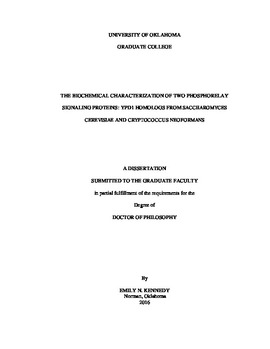| dc.description.abstract | Histidine-to-aspartate multi-step phosphorelay systems are used extensively by eukaryotes and bacteria to sense and respond to changes in their external environment and to control the regulation of crucial biological functions such as cell cycle, mating, and virulence. These pathways generally consists of a hybrid histidine kinase (HHK), a single histidine phosphotransfer protein (HPt), and one or more response regulator proteins (RR). The histidine phosphotransfer protein, Ypd1, is found at the branch point of these signal transduction pathways in several fungal organisms, and acts as an intermediate that is responsible for relaying messages between the HHK, which senses the signal, and the RR, which initiates a cellular response. This protein, or a homolog, is often the sole HPt in fungal organisms. In several fungal species it has been shown to be essential for viability. These organisms include the common baker’s yeast Saccharomyces cerevisiae (Sc) and the human fungal pathogen Cryptococcus neoformans (Cn).
HPt proteins are genetically diverse, but share a common tertiary fold with conserved residues near the active site. A surface-exposed glycine at the H+4 position, relative to the phosphorylatable histidine is found in a significant number of annotated HPts. Substitution of residues with larger side chains at this position typically disrupts signal transduction by altering the structure and/or enzymatic activity of the phosphotransfer-competent complex formed between HPts and their cognate partners.
Previous work using yeast two-hybrid assays has shown that the residue in the H+4 position on the surface of ScYpd1 in the G68 position has an only slightly diminished activity in its ability to accept a phosphoryl group from the receiver domain of ScSln1, but a highly diminished activity in its ability to transfer its phosphoryl group to the receiver domain of ScSsk1. Here we report a comprehensive analysis of a set of point mutants at position 68 of Ypd1 to gain insights into the evolutionary constraints leading to the exceptionally high conservation of glycine at position H+4 in HPts. We combine bioinformatics, phosphoryl transfer assays, X-ray crystallography, fluorescence-based binding assay and molecular dynamics techniques to help explain the delicate balance of interatomic interactions required for phosphotransfer to occur between an HPt and its cognate RR. The conclusions that can be drawn clarify the importance of a small and/or hydrophilic residue in the H+4 position.
Ypd1 from C. neoformans is distinct from Ypd1 from S. cerevisiae. Based on sequence alignments, CnYpd1 includes an extended N-terminal region that is not present in ScYpd1 of approximately 60 residues. This extended N-terminal region shares no close sequence homology with any other known protein domain. Organisms with stand-alone HPt proteins that include an extended N-terminal region are rare, and are found strictly in fungal species that have been shown to be pathogenic to plants or humans, or that live in extreme environments. Results from this study indicate that CnYpd1 exhibits unique characteristics in comparison to other histidine phosphotransfer proteins, such as an extended N-terminal amino acid sequence, which we find contributes to structural integrity, a longer phosphorylated life-time and the ability to bind calcium ions. | en_US |
